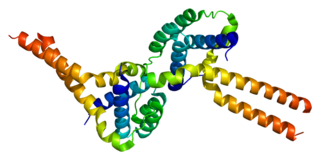
Gray platelet syndrome (GPS), or platelet alpha-granule deficiency, is a rare congenital autosomal recessive bleeding disorder caused by a reduction or absence of alpha-granules in blood platelets, and the release of proteins normally contained in these granules into the marrow, causing myelofibrosis. The name derives from the initial observation of gray appearance of platelets with a paucity of granules on blood films from a patient with a lifelong bleeding disorder.

Platelet-activating factor acetylhydrolase IB subunit alpha or Lisencephaly protein-1 (LIS-1) is an enzyme that in humans is encoded by the PAFAH1B1 gene. The protein plays an important role in regulating the motor protein dynein.

The thrombopoietin receptor also known as the myeloproliferative leukemia protein or CD110 is a protein that in humans is encoded by the MPL oncogene.

Pallidin is a protein that in humans is encoded by the PLDN gene.

BCL-6 corepressor is a protein that in humans is encoded by the BCOR gene.

Zinc finger and BTB domain-containing protein 20 is a protein that in humans is encoded by the ZBTB20 gene.

Myosin-3 is a protein that in humans is encoded by the MYH3 gene.

Protein Muted homolog is a protein that in humans is encoded by the MUTED gene.

Unconventional myosin-XV is a protein that in humans is encoded by the MYO15A gene.

Zing finger protein 644 (ZNF644) also known as zinc finger motif enhancer-binding protein 2 (Zep-2) is a protein that in humans is encoded by the ZNF644 gene.

NOP2/Sun domain family, member 2 is a protein that in humans is encoded by the NSUN2 gene. Alternatively spliced transcript variants encoding different isoforms have been noted for the gene.

Synaptotagmin XIV is a protein that in humans is encoded by the SYT14 gene.

Coiled-coil domain containing 8 is a protein that in humans is encoded by the CCDC8 gene.

AFG3 ATPase family gene 3-like 2 is a protein that in humans is encoded by the AFG3L2 gene.

Serine active site-containing protein 1, or Protein SERAC1 is a protein in humans that is encoded by the SERAC1 gene. The protein encoded by this gene is a phosphatidylglycerol remodeling protein found at the interface of mitochondria and endoplasmic reticula, where it mediates phospholipid exchange. The encoded protein plays a major role in mitochondrial function and intracellular cholesterol trafficking. Defects in this gene are a cause of 3-methylglutaconic aciduria with deafness, encephalopathy, and Leigh-like syndrome (MEGDEL). Two transcript variants, one protein-coding and the other non-protein coding, have been found for this gene.

Dynactin subunit 4 is a protein that in humans is encoded by the DCTN4 gene.

Phosphatidylinositol glycan anchor biosynthesis, class N is a protein that in humans is encoded by the PIGN gene.

ADAM metallopeptidase with thrombospondin type 1 motif, 17 is a protein that in humans is encoded by the ADAMTS17 gene.

NADH:ubiquinone oxidoreductase complex assembly factor 6 is a protein that in humans is encoded by the NDUFAF6 gene. The protein is involved in the assembly of complex I in the mitochondrial electron transport chain. Mutations in the NDUFAF6 gene have been shown to cause Complex I deficiency, Leigh syndrome, and Acadian variant Fanconi Syndrome.

Structural Maintenance of Chromosomes flexible Hinge Domain Containing 1 (SMCHD1) is a protein that in humans is encoded by the SMCHD1 gene. Mutations in SMCHD1 are causative for development of facioscapulohumeral muscular dystrophy type 2 (FSHD2) and Bosma arhinia microphthalmia syndrome (BAMS).
















